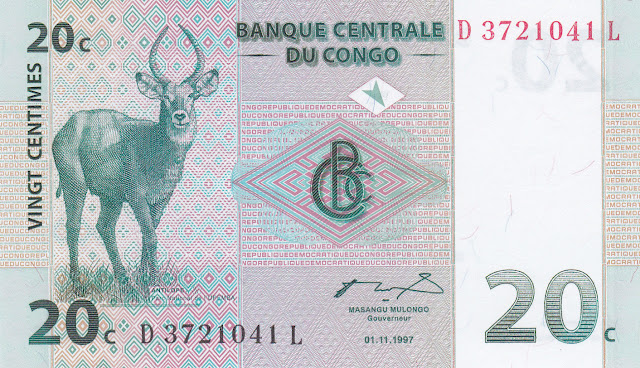Congo Democratic Republic 20 Centimes banknote 1997
Central Bank of the Congo - Banque Centrale du Congo
Obverse: Waterbuck (Kobus ellipsiprymnus) antelope (antilope) - typical animal of Congolese savanna at left. Centered is the monogram of the Bank of Democratic Republic of the Congo. Denominations in numerals are in three corners. In words on the left side.
Reverse: Herd of Waterbuck antelopes under the big tree, in savannah, near watering place in Upemba National Park. Denominations in numerals are in three corners.
Watermark: Single Okapi head or multiple Okapi heads repeated vertically.
Main color: Blue-green and black on multicolored underprint.
Size: 121 x 70 mm.
Printer: AB Tumba Bruk (ATB)., (Tumba Bruk is the printing company responsible for manufacturing of the Swedish krona banknotes).
Congo Democratic Republic Banknotes and Paper Money
1997-2013 Issue
Waterbuck
The waterbuck (Kobus ellipsiprymnus) is a large antelope found widely in sub-Saharan Africa. It is placed in the genus Kobus of the family Bovidae. It was first described by Irish naturalist William Ogilby in 1833. The thirteen subspecies are grouped under two varieties: the common or ellipsen waterbuck and the defassa waterbuck. The head-and-body length is typically between 177–235 cm (70–93 in) and the average height is between 120 and 136 cm (47 and 54 in). A sexually dimorphic antelope, males are taller as well as heavier than females. Males reach approximately 127 cm (50 in) at the shoulder, while females reach 119 cm (47 in). Males typically weigh 198–262 kg (437–578 lb) and females 161–214 kg (355–472 lb). The coat colour varies from brown to grey. The long, spiral horns, present only on males, curve backward, then forward and are 55–99 cm (22–39 in) long.
Waterbuck are rather sedentary in nature. A gregarious animal, the waterbuck may form herds consisting of six to 30 individuals. These groups are either nursery herds with females and their offspring or bachelor herds. Males start showing territorial behaviour from the age of five years, but are most dominant from the age of six to nine. The waterbuck can not tolerate dehydration in hot weather, and thus inhabits areas close to sources of water. Predominantly a grazer, the waterbuck is mostly found on grassland. In equatorial regions, breeding takes place throughout the year, but births are at their peak in the rainy season. The gestational period lasts for seven to eight months, followed by the birth of a single calf.
Waterbuck inhabit scrub and savanna areas along rivers, lakes and valleys. Due to their requirement for grasslands as well as water, the waterbuck have a sparse ecotone distribution. The IUCN lists the waterbuck as being of Least Concern. More specifically, the common waterbuck is listed as of Least Concern while the defassa waterbuck is Near Threatened. The population trend for both the common and defassa waterbuck is downwards, especially that of the latter, with large populations being eliminated from certain habitats because of hunting and human disturbance.
Upemba National Park
Upemba National Park is a large national park in Katanga Province of the southeastern Democratic Republic of Congo, formerly Zaire.
At the time of the creation of Upemba National Park, on 15 May 1939, the park had a surface area of 17,730 square kilometres (6,850 sq mi). It was the largest park in Africa. In July 1975, the limits were revised and today the integral park has an area of 10,000 square kilometres (3,900 sq mi) with an annex of a further 3,000 square kilometres (1,200 sq mi).
Its lower section is located in the Upemba Depression, a lush area of lakes and marshes including the eponymous Lake Upemba, and bordered by the Lualaba River. Its higher section is in the dryer Kibara Plateau mountains.
There are also a handful of villages in the park. In recent years, the park has come under considerable attack from poachers and local militias. On 28 May 2004, for instance, the park headquarters in Lusinga came under attack by the Mai Mai militia. Several wardens and their families were killed, the headquarters were burned down, and the family of the chief warden was taken hostage.
On 1 June 2005, the protectors of the park received the Abraham Conservation Award for their role in protecting the rich biodiversity of the Congo River basin.
The habitat of the park varies from grassland at higher altitudes, through forests, woodlands, to rainforest, and lakes and streams with riparian zones, marshes, and wetlands at lowest altitudes. It is home to some 1,800 different species, some of them discovered as late as 2003.
Lake Upemba has a maximum depth reported to be only 3.2 metres (10 ft) and it is a site of intense algae growth. The watercourses of the region fluctuate according to the season and the water level in the lakes is high from March to June, and low from October to January. Many of the bodies of the water in the area are characterized by extensive swamps, with papyrus, Nile lettuce and water caltrop among other species.
The system of lakes, rivers, swamps and wetlands supports a variety of fish fauna. This includes over 30 species of Cyprinidae, Mormyridae (also known as freshwater elephant fish), Barbus, Alestidae, Mochokidae and Cichlidae.
Bird species include several threatened or endangered species, such as the shoebill, wattled crane and spotted ground-thrush.

